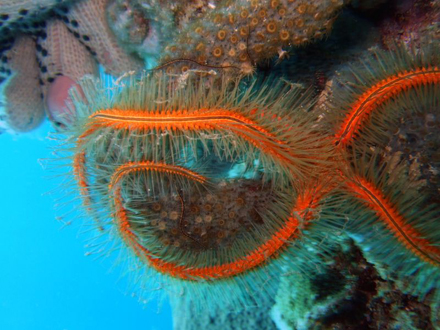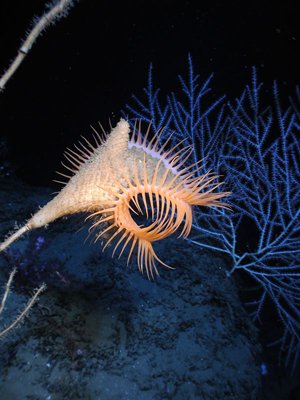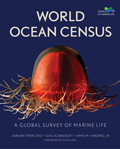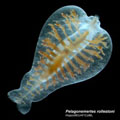Navigation
Historic Census of Marine Life (COML) Roll Call of Marine Species Published
Representing the most comprehensive and authoritative answer yet to one of humanity's most ancient questions, "what lives in the sea?" Census of Marine Life scientists on August 2, 2010 released an inventory of species distribution and diversity in key global ocean areas.
 |
| Sponge Brittle Star Photo Credit: César Herrera |
Representing the most comprehensive and authoritative answer yet to one of humanity's most ancient questions, "what lives in the sea?" Census of Marine Life scientists on August 2, 2010 released an inventory of species distribution and diversity in key global ocean areas.
Scientists combined information collected over centuries with data obtained during the decade-long Census to create a roll call of species in 25 biologically representative regions -- from the Antarctic through temperate and tropical seas to the Arctic.
Their papers help set a baseline for measuring changes that humanity and nature will cause.
Published by the open access journal PLoS ONE, the landmark collection of papers and overview synthesis will help guide future decisions on exploration of still poorly-explored waters, especially the abyssal depths, and provides a baseline for still thinly-studied forms, especially small animals.
Australian and Japanese waters, which each feature almost 33,000 forms of life that have earned the status of "species" (and thus a scientific name such as Carcharodon carcharias,a.k.a. the great white shark), are by far the most biodiverse. The oceans off China, the Mediterranean Sea and the Gulf of Mexico round out the top five areas most diverse in known species.
In a prelude to the ultimate summary of the landmark, decade-long marine census, to be released October 4, 2010 in London, national and regional committees of the Census compiled the inventory of known and new species in the 25 key marine regions.
The 13 committees include over 360 scientists whose collective knowledge, including published and unpublished data, was assembled to create the initial profile of known marine biodiversity in Antarctica, Atlantic Europe, Australia, Baltic Sea, Brazil, Canada (East, West and Arctic), Caribbean Sea, China, Indian Ocean, Japan, Mediterranean Sea, New Zealand, South Africa, South America (Tropical East Pacific and Tropical West Atlantic), South Hawaii, Gulf of Mexico, and California).
Major inventories continue in highly diverse areas such as Indonesia, Madagascar and the Arabian Sea, which have yet to report.
Scientists find that the number of known, named species contained in the 25 areas ranged from 2,600 to 33,000 and averaged about 10,750, which fall into a dozen groups. On average, about one-fifth of all species were crustaceans which, with mollusks and fish, make up half of all known species on average across the regions.
The full breakdown follows:
* 19% Crustaceans (including crabs, lobsters, crayfish, shrimp, krill and barnacles)
* 17% Mollusca (including squid, octopus, clams, snails and slugs)
* 12% Pisces (fish, including sharks)
* 10% Protozoa (unicellular micro-organisms)
* 10% algae and other plant-like organisms
* 7% Annelida (segmented worms)
* 5% Cnidaria (including sea anemones, corals and jellyfish)
* 3% Platyhelminthes (including flatworms)
* 3% Echinodermata (including starfish, brittle stars, sea urchins, sand dollars and sea cucumbers)
* 3% Porifera (including sponges)
* 2% Bryozoa (mat or ¡®moss animals¡¯)
* 1% Tunicata (including sea squirts)
The rest are other invertebrates (5%) and other vertebrates (2%). The scarce 2% of species in the other vertebrates category includes whales, sea lions, seals, sea birds, turtles and walruses. Thus some of the best-known marine animals comprise a tiny part of marine
biodiversity.
The authors note that their work constitutes a roll call of marine plant and animal species, either present or absent in 25 regions. It does not represent the abundance or biomass they represent.
The most cosmopolitan species
Many species appear in more than one region. Current holders of the title "most cosmopolitan" marine species are two opposite kinds: microscopic plants (algae) and single celled animals called protozoa and copepod in the plankton, and the seabirds and marine mammals that traverse the oceans throughout their lives.
Among fish, the manylight viperfish (Chauliodus sloani) can be considered the Everyman of the deep ocean. Census data shows the fish has been recorded in more than one-quarter of the world's marine waters.
How the microscopic species can be cosmopolitan is still a subject of research, and may be due to their ability to survive unsuitable environmental conditions and then reach enormous abundance in a suitable environment.
Patricia Miloslavich of Universidad Simón Bolívar, Venezuela, co-senior scientist of the Census and leader of the regional studies said,"To create this baseline, the Census of Marine Life explored new areas and new ecosystems, discovering new species and records of species in new places.
"We reviewed what had been documented through the huge efforts of scientists in years past. However, most of this information was scattered or unavailable except at a very local level. The Census has made a tremendous contribution by bringing order to chaos. This previously scattered information is now all reviewed, analyzed and presented in a collection of papers at an open access journal.
The lead author of the summary, Mark Costello of the Leigh Marine Laboratory, University of Auckland, New Zealand said, "Sparse, uneven marine sampling in much of the world underlies this initial inventory, and future research will undoubtedly alter the profile presented today."
He adds that finding such great difference in the proportions of species across regions challenges assumptions that scientists can extrapolate knowledge of biodiversity from one location to another.
"This inventory was urgently needed for two reasons," says Dr. Costello. "First, dwindling expertise in taxonomy impairs society's ability to discover and describe new species. And, secondly, marine species have suffered major declines -- in some cases 90% losses -- due to human activities and may be heading for extinction, as happened to many species on land."
Regional results:
- Even less diverse regions such as the Baltic or Northeast USA still have about 4,000 known species.
- Relative to its volume of water, the Baltic, followed by China, has some of the highest known diversity.
- Relative to their seabed area, South Korea, China, South Africa and the Baltic, had most species.
- The relative contribution of different kinds of life to the species in each region varied greatly and enigmatically. While variation in research effort may be part of the explanation, it also seems that species have not flourished equally around the world.
- Crustaceans (including crabs, lobsters, crayfish, shrimp, krill and barnacles) contributed 22% to 35% of species for Alaska, Antarctica, Arctic, Brazil, California, Caribbean, and Humboldt regions, but only 10% for the Baltic.
- Mollusks (clams, snails, squid and slugs) contributed 26% of the species in Australia and Japan, but only 5% to 7% of the species in the Baltic, California, Arctic, and Eastern and Western Canada.
Fish comprised 28% of species in the Tropical West Atlantic and Southeast USA, but only 3% to 6% for the Arctic, Antarctica, Baltic, and Mediterranean.
- Of the less species-rich groups, Annelida (worms) contributed 28% of the species for the Tropical Eastern Pacific, but only 3% for Japan.
- Plants and algae (mostly algae) contributed about one third of species in the Baltic, Arctic, Atlantic Europe, and Western Canada, but few in Antarctica, Caribbean, China, Humboldt, Tropical Eastern Pacific, and Tropical Western Atlantic.
Where to find unique, "endemic"or alien invasive species
- The number of unique "endemic" species seen nowhere else on Earth provides another measure of biodiversity. The relatively isolated regions Australia, New Zealand, Antarctica or South Africa have the most endemic species. They may have suffered fewer extinctions from climate cooling thousands of years ago during glaciation. Or, species from regions that escaped glaciers may have reached them more easily when the glaciers melted.
Endemics comprise about half of New Zealand and Antarctic marine species and a quarter of those in Australian and South Africa. The Caribbean, China, Japan, and Mediterranean each have less than 2,000 endemic species, and the Baltic only 1, a seaweed (Fucus radicans).
- To encounter invasive species, visit the Mediterranean. It had the most alien species among the 25 regions with over 600 (4% of the all species inventoried), most of which arrived from the Red Sea via the Suez Canal.
- Many aliens have also invaded the European Atlantic, New Zealand, Australian Pacific, and Baltic waters. Mollusks, crustaceans, and fish were the most common invading aliens.
How much is unknown?
Dr. Ian Poiner, CEO of the Australian Institute for Marine Science and Chair of the Census Scientific Steering Committee said, "Consider that a well-informed person walking along a familiar seashore might identify 20 species or so; a fish monger perhaps 100. Even in the world's least diverse marine regions, there are 50 to 100 times as many named species than an expert would know without resorting to field guides."
Many of the species records used for the report are part of the 10-year-old Ocean Biogeographic Information System (OBIS), a massive global database of what/where records and a major Census legacy. An interested person can find precise places on a world map where a marine organism has been reliably observed.
OBIS has consolidated almost 30 million records from the Census projects and more than 800 databases contributed by institutions around the world.
Edward Vanden Berghe, who leads development and management of the database said, "A map of records in OBIS today underlines the uneven sampling of oceanic regions," he adds. "So even as records accumulate, the importance of orderly sampling grows."
 |
| Venus fly-trap, Actinoscyphia sp. Photo Credit: I. MacDonald |
Almost all the species in the key regional areas are included in the unprecedented list of 185,000 marine species created by the World Register of Marine Species (WoRMS), an affiliate of the Census of Marine Life.
In October 2010 the Census will release its latest estimate of all marine species known to science, including those still to be added to WoRMS and OBIS. This is likely to exceed 230,000.
According to a recent open access Census of Marine Life paper in Zootaxa by US expert Bill Eschmeyer and colleagues, the number of marine fish species in mid-February stood at 16,764, and was growing at a rate of 100 to 150 per year. They estimate about 5,000 marine fish species have yet to be discovered and described, twice the number described in the last 19 years, for a projected total of approximately 21,800 marine fish species around the world.
And for every marine species of all kinds known to science, Census scientists estimate that at least four have yet to be discovered. In a few taxonomic groups, like fish, scientists believe more than 70% of species have been discovered, but for most other groups likely less than
one-third are known. Scientists believe that the tropics, deep-seas and southern hemisphere hold the most undiscovered marine species.
The proportion of species not yet described is estimated at 39 to 58% in Antarctica, 38% for South Africa, 70% for Japan, 75% for the Mediterranean deep-sea, and more than 80% for Australia.
New Zealand has more than 4,100 undescribed species in its specimen collections, which would comprise 25% of the country's known marine species, but clearly is a minimum estimate because many species have not been collected and distinguished in collections.
Citizens of the Sea
"At the end of the Census of Marine Life, most ocean organisms still remain nameless and their numbers unknown," says renowned biologist Nancy Knowlton of the Smithsonian Institution, leader of the Census' coral reef project and author of a new book published by the National Geographic Society for release September 14, 2010, Citizens of the Sea: Wondrous Creatures from the Census of Marine Life, one of three books marking the Census' conclusion.
"This is not an admission of failure. The ocean is simply so vast that, after 10 years of hard work, we still have only snapshots, though sometimes detailed, of what the sea contains. But it is an important and impressive start."
Dr. Knowlton's book, written in everyday language and populated with scores of images, draws on discoveries of Census scientists and their colleagues, past and present. It chronicles the "variety, beauty, weirdness and wonder that characterizes life in the sea."
"The sea today is in trouble," says Dr. Knowlton. "Its citizens have no vote in any national or international body, but they are suffering and need to be heard. Much has changed just in the few decades that I have spent on and under the sea, but it remains a wondrous and enriching place, and with care it can become even more so."
Greatest threats
According to the Census studies published in PLoS ONE, the main threats to marine life to date have been overfishing, lost habitat, invasive species and pollution, although the relative importance of the threats varied among regions. Emerging threats include rising water temperature and acidification, and the enlargement of areas characterized by low oxygen content (called hypoxia) of seawater. These too will vary regionally (surface temperature, for example) whereas others are more global (such as acidification).
Overfishing not only depletes the exploited fish themselves but also depletes other species like turtles, albatrosses, sharks and mammals, caught unintentionally. It alters food webs within ecosystems.
Coastal urbanization, sediment runoff and nutrients in sewage and fertilizer washed from the land and causing eutrophication and hypoxia are destroying marine habitats.
The more enclosed seas, Mediterranean, Gulf of Mexico, China's shelves, Baltic, and Caribbean, were reported to have the most threatened biodiversity.
State-of-knowledge index
Census scientists created a relative "state-of-knowledge index," grading each region according to how well it was known, including the availability of guides to the identification of species and their number of taxonomic experts.
In a nutshell, the studies found that while the depth of knowledge varies across regions, knowledge in all regions is inadequate.
Australia, China and all three European regions scored the highest index results while the Tropical West Atlantic, Tropical East Pacific and Canadian Arctic were well below average. But, even in regions with the highest index scores, knowledge of marine biodiversity is poor. In Australia it is estimated that only about 10% of marine life in its Exclusive Economic Zone is known.
Scientists say the availability of comprehensive species identification guides strongly boost the discovery and management of marine biodiversity resources.
"We must increase our knowledge of unknown biodiversity more quickly, lest much of it is lost without even being discovered," says Dr. Miloslavich. "International sharing of data,expertise and resources, as has been accomplished through the Census of Marine Life, is the most cost-effective way of achieving this."
The Census papers collection, freely available on August. 2, 2010 at PLoS ONE includes two overview articles and links to maps, databases and a suite of the first ten regional papers on which the summary drew, with several more to be added in weeks to come.
And there are Census reports on several more regions anticipated in years to come.
A exploration currently underway in the species-rich Timor and Arafura Seas, facilitated by Dr. Antonio (Tonny) Wagey, leader of the Census' National Committee in Indonesia, will enrich the Indonesian report.
Another this past spring, led by Philippe Bouchet of the Muséum National d'Histoire Naturelle, Paris, discovered a vast array of marine life in the Deep South of Madagascar.
This news is from the Census of Marine Life and from PLoS, 2 August 2010.
Visit the Video Gallery at http://www.coml.org/what-lives-sea-video-gallery.
Notes:
From PLoS: Please check out this call for articles to find out more about publishing your Biodiversity research in the PLoS journals so that it may be considered for inclusion in the Hub which launches in the Fall 2010
From Horizon International:
Visit the feature with many fascinating images from the Census of Marine Life on Horizon's Magic Porthole at www.magicporthole.org.
And, related articles on the Solutions Site are:
 |
Started in the year 2000, Census of Marine Life (CoML) is an international science research program uniting thousands of researchers worldwide with the goal of assessing and explaining the diversity, distribution and abundance of marine life - past, present and future - by 2010. World Ocean Census: A Global Survey of Marine Life published by Firefly Books, October 15, 2009, is the only officially sanctioned book to bring the Census and its discoveries to the general reader.
Please click on title to go to full article.
and
 |
Earth's unique, forbidding ice oceans of the Arctic and Antarctic have revealed a trove of secrets to Census of Marine Life explorers, who were especially surprised to find at least 235 species live in both polar seas despite an 11,000-kilometer distance in between.
Please click on title to go to full article.
Feb 15, 2009, 13:00
A video by the Census of Marine Life about why we need to monitor biodiversity in the oceans and how it can be done using existing technologies on a global scale. For more information visit http://www.coml.org.
Search
Latest articles
Agriculture
- World Water Week: Healthy ecosystems essential to human health: from coronavirus to malnutrition Online session Wednesday 24 August 17:00-18:20
- World Water Week: Healthy ecosystems essential to human health: from coronavirus to malnutrition Online session Wednesday 24 August 17:00-18:20
Air Pollution
- "Water and Sanitation-Related Diseases and the Changing Environment: Challenges, Interventions, and Preventive Measures" Volume 2 Is Now Available
- Global Innovation Exchange Co-Created by Horizon International, USAID, Bill and Melinda Gates Foundation and Others
Biodiversity
- World Water Week: Healthy ecosystems essential to human health: from coronavirus to malnutrition Online session Wednesday 24 August 17:00-18:20
- Mangrove Action Project Collaborates to Restore and Preserve Mangrove Ecosystems
Desertification
- World Water Week: Healthy ecosystems essential to human health: from coronavirus to malnutrition Online session Wednesday 24 August 17:00-18:20
- UN Food Systems Summit Receives Over 1,200 Ideas to Help Meet Sustainable Development Goals
Endangered Species
- Mangrove Action Project Collaborates to Restore and Preserve Mangrove Ecosystems
- Coral Research in Palau offers a “Glimmer of Hope”
Energy
- Global Innovation Exchange Co-Created by Horizon International, USAID, Bill and Melinda Gates Foundation and Others
- Wildlife Preservation in Southeast Nova Scotia
Exhibits
- Global Innovation Exchange Co-Created by Horizon International, USAID, Bill and Melinda Gates Foundation and Others
- Coral Reefs
Forests
- NASA Satellites Reveal Major Shifts in Global Freshwater Updated June 2020
- Global Innovation Exchange Co-Created by Horizon International, USAID, Bill and Melinda Gates Foundation and Others
Global Climate Change
- World Water Week: Healthy ecosystems essential to human health: from coronavirus to malnutrition Online session Wednesday 24 August 17:00-18:20
- Mangrove Action Project Collaborates to Restore and Preserve Mangrove Ecosystems
Global Health
- World Water Week: Healthy ecosystems essential to human health: from coronavirus to malnutrition Online session Wednesday 24 August 17:00-18:20
- More than 400 schoolgirls, family and teachers rescued from Afghanistan by small coalition
Industry
- "Water and Sanitation-Related Diseases and the Changing Environment: Challenges, Interventions, and Preventive Measures" Volume 2 Is Now Available
- Global Innovation Exchange Co-Created by Horizon International, USAID, Bill and Melinda Gates Foundation and Others
Natural Disaster Relief
- STOP ATTACKS ON HEALTH CARE IN UKRAINE
- Global Innovation Exchange Co-Created by Horizon International, USAID, Bill and Melinda Gates Foundation and Others
News and Special Reports
- World Water Week: Healthy ecosystems essential to human health: from coronavirus to malnutrition Online session Wednesday 24 August 17:00-18:20
- STOP ATTACKS ON HEALTH CARE IN UKRAINE
Oceans, Coral Reefs
- World Water Week: Healthy ecosystems essential to human health: from coronavirus to malnutrition Online session Wednesday 24 August 17:00-18:20
- Mangrove Action Project Collaborates to Restore and Preserve Mangrove Ecosystems
Pollution
- Zakaria Ouedraogo of Burkina Faso Produces Film “Nzoue Fiyen: Water Not Drinkable”
- "Water and Sanitation-Related Diseases and the Changing Environment: Challenges, Interventions, and Preventive Measures" Volume 2 Is Now Available
Population
- "Water and Sanitation-Related Diseases and the Changing Environment: Challenges, Interventions, and Preventive Measures" Volume 2 Is Now Available
- "Water and Sanitation-Related Diseases and the Changing Environment: Challenges, Interventions, and Preventive Measures" Volume 2 Is Now Available
Public Health
- Honouring the visionary behind India’s sanitation revolution
- Honouring the visionary behind India’s sanitation revolution
Rivers
- World Water Week: Healthy ecosystems essential to human health: from coronavirus to malnutrition Online session Wednesday 24 August 17:00-18:20
- Mangrove Action Project Collaborates to Restore and Preserve Mangrove Ecosystems
Sanitation
- Honouring the visionary behind India’s sanitation revolution
- Honouring the visionary behind India’s sanitation revolution
Toxic Chemicals
- "Water and Sanitation-Related Diseases and the Changing Environment: Challenges, Interventions, and Preventive Measures" Volume 2 Is Now Available
- Actions to Prevent Polluted Drinking Water in the United States
Transportation
- "Water and Sanitation-Related Diseases and the Changing Environment: Challenges, Interventions, and Preventive Measures" Volume 2 Is Now Available
- Urbanization Provides Opportunities for Transition to a Green Economy, Says New Report
Waste Management
- Honouring the visionary behind India’s sanitation revolution
- Honouring the visionary behind India’s sanitation revolution
Water
- Honouring the visionary behind India’s sanitation revolution
- Honouring the visionary behind India’s sanitation revolution
Water and Sanitation
- Honouring the visionary behind India’s sanitation revolution
- Honouring the visionary behind India’s sanitation revolution

